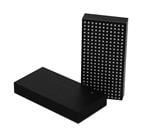- Home
- Symmetry Blog
- Powering IoT
Powering IoT
Enhancing IoT Device Capability through Power Management Solutions
About Symmetry Electronics
Established in 1998, Symmetry Electronics, a Division of Braemac, is a global distributor of electronic components and systems. Combining premier components and comprehensive value-added services with an expert in-house engineering team, Symmetry supports engineers in the design, development, and deployment of a broad range of connected technologies.
Exponential Technology Group Member
Acquired by Berkshire Hathaway company TTI, Inc. in 2017, Symmetry Electronics is a proud Exponential Technology Group (XTG) member. A collection of specialty semiconductor distributors and engineering design firms, XTG stands alongside industry leaders TTI Inc., Mouser Electronics, and Sager Electronics. Together, we provide a united global supply chain solution with the shared mission of simplifying engineering, offering affordable technologies, and assisting engineers in accelerating time to market. For more information about XTG, visit www.xponentialgroup.com.

Energy and power are often used as interchangeable terms. However, when it comes to electrical engineering, energy and power hold completely different meanings. The difference between energy and power revolves around transferal. According to Energy Education, “Energy is the ability to create a change, [whereas] power is how fast energy is used or transmitted.” In other words, energy is the fuel and power is the engine using it. In the scope of the Internet of Things (IoT), a device’s power management solution can make or break how efficiently it uses its energy.
4 Common Types of Power Management Solutions
When selecting a power supply option for an IoT device, it is essential to select a component that extends battery life and enhances functionality. When determining an optimal power management solution, it is important to consider the component’s maximum I/O and frequency range. As a leading distributor of wireless video and embedded semiconductors, Symmetry Electronics offers a comprehensive line card with suppliers that specialize in providing customers with dynamic power management solutions.
1. Power Modules
If your IoT device requires a comprehensive option for high-power switching, power modules are an advantageous solution. Power modules are high-performance, isolated units that contain singular or multiple components that enhance handling and reliability, while decreasing the opportunity for parasitic circuit elements. According to Monolithic Power Systems (MPS), “Power modules are the next step in power management evolution.” MPS’ line of high-current power modules, including high-current modules like the MPM3695-10 or the MPM82504 directly address rapidly evolving design requirements. MPS’ high-current power modules offer exceptional performance at the smallest footprint possible.
2. Battery Charger ICs
Selecting a battery charger integrated circuit (IC) as a preferred power management solution for an IoT design offers distinct advantages. Battery charger ICs are specifically designed to efficiently and safely recharge batteries to ensure an uninterrupted power supply for IoT devices. They provide sophisticated charging algorithms to optimize charging processes for various battery chemistries.
Their compact and integrated nature simplifies design complexity and saves valuable space in IoT designs. Additionally, battery charger ICs often incorporate features like thermal protection and voltage regulation to enhance the overall reliability, lifespan, and efficiency of connected batteries.
Silvertel’s Ag102S is their first battery charger module. Designed to maximize battery lifetime while reducing power consumption, the Ag102S is an ecofriendly solution for use in charging 12V sealed lead acid (SLA) batteries between 1.2Ah and 7Ah capacity.
Additionally, MPS’ innovative MP2639A-Z is a highly flexible switch-mode battery charging management device for use in 2-cell series Li-ion and Li-polymer batteries. With wide ranging applications in power stations, power banks, and other portable devices, the MP2639A is compatible with 5V input and integrated bi-directional charge/discharge with cell balance.
3. Voltage Converters
Voltage converters allow for storage and integration of alternating current into reactive impedance elements like indicators (I) and capacitators (C). The use of a voltage converter is beneficial because it separates positive and negative potential power. There are many different types of voltage converters, but generally they can be broken down into three basic categories:
Buck Converters
A buck converter, also known as a step-down converter, is a type of DC-DC converter designed to lower the input voltage to a desired lower output voltage. It operates by intermittently switching the input voltage across an inductor and then smoothing the output through a diode and capacitor. During the on-time of the switching cycle, energy is stored in the inductor, and during the off-time, this stored energy is transferred to the load. The key advantage of buck converters is their ability to efficiently regulate and reduce voltage levels, making them widely used in electronics where a lower, stable voltage is required. Common applications include powering portable devices, such as smartphones and battery-operated electronics, where maximizing energy efficiency and extending battery life are crucial considerations.
- MPS’s buck converters, including their MP2161AGJ-Z provide:
- Built-in internal power MOSFETs
- 2A of continuous output current from a 2.5V to 6V input voltage
- Excellent load and line regulation
Boost Converters
Boost converters, also known as step-up converters, are a type of voltage converter designed to increase the input voltage to a higher output voltage level. These converters are essential in situations where the voltage supplied by the power source is lower than the required voltage for a particular device or application. Boost converters operate by storing energy in an inductor during one part of the switching cycle and releasing it to the output during another part, effectively "boosting" the voltage. This process allows boost converters to provide a regulated and higher output voltage, making them valuable in a variety of applications, such as powering LED drivers, battery chargers, and other electronic devices that demand a voltage level greater than that supplied by the input source.
- The MPQ3426DL-LF-P is a current-mode step-up converter from MPS features:
- 6A, 90mΩ, 45V Power MOSFET Supports Battery Range up to 45V (Load Dump)
- Range: 3.2V to 22V
- Ideal for Automotive Pre-Boost Applications
Buck/Boost Converters
Buck/boost converters are versatile voltage converters that can step up (boost) or step down (buck) an input voltage to maintain a stable and regulated output voltage. This dual functionality makes them particularly useful in scenarios where the input voltage can vary, and the output needs to be consistent. In the buck mode, the converter lowers a higher input voltage to a desired lower output voltage, while in the boost mode, it increases a lower input voltage to a desired higher output voltage. This flexibility makes buck/boost converters valuable in various applications, including battery-powered devices, solar power systems, and electronics that require a constant power supply despite fluctuations in the input voltage. Their efficiency, compact size, and ability to handle both step-up and step-down tasks contribute to their widespread use in modern electronic systems.
- MPS’s Buck/Boost Converters, like their MP28167GQ-A-Z and MP2151GTF-Z are known for they superior performance and provide:
- Design Flexibility
- High power efficiency- load disconnect during shutdown & selectable mode & External sync pin
4. Controllers
Controllers are electronic devices designed to manage and control the delivery of electrical power to various loads or systems. Their primary function is to regulate the power supplied to connected devices, ensuring optimal performance, efficiency, and safety. Power controllers come in various forms, including solid-state relays, thyristors (such as silicon-controlled rectifiers or SCRs), and integrated circuits. These controllers enable precise adjustment of voltage, current, or both, allowing for accurate control of electrical parameters in industrial processes, heating systems, motor drives, and other applications.
By dynamically adjusting the power delivered to loads, power controllers contribute to energy efficiency, enhance system stability, and protect equipment from overvoltage or overcurrent conditions. Their versatility makes them integral components in the automation and control of diverse electrical systems, providing a crucial link between power sources and the devices they power.
Along with their other power management solutions, MPS provides an extensive line of controllers. Their MP2918GF-Z is a high-voltage, synchronous step-down controller that features a wide 4V to 60V operating input range. MPS also offers the MP3910AGS-Z, a peak current mode PWM controller. It features a 9V to 14V supply voltage range, a 1A MOSFET gate driver, and more.
Conclusion
In conclusion, efficient and reliable power management in IoT device design is crucial for optimal functionality, longevity, and overall performance. As technology continues to advance, the careful consideration and selection of these power management solutions play a pivotal role in shaping the success of IoT applications across various industries. Whether it's powering portable devices, optimizing charging processes, or regulating voltage levels, the diverse lineup of solutions presented here underscores the importance of robust power management strategies in the rapidly evolving IoT landscape.









